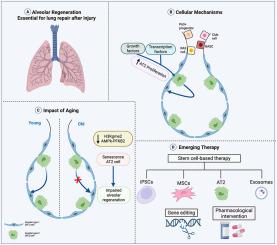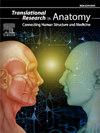Exploring the frontier of lung alveolar regeneration: Cellular dynamics, aging effects, and emerging therapeutics
Q3 Medicine
引用次数: 0
Abstract
Background
Alveolar regeneration is essential for maintaining lung function and enabling recovery following lung injury. Impairment of this process contributes to the progression of various respiratory diseases. A detailed understanding of the cellular and molecular mechanisms driving alveolar repair is crucial for the development of effective therapeutic strategies.
Methods
A literature search was conducted in PubMed, Scopus, and Google Scholar focusing on the history of alveolar regeneration and the cells involved in this process, the effects of aging, and associated therapeutic implications. The keywords used in the search included “alveolar regeneration,” “aging,” “cell senescence,” “stem cells,” “growth factors,” and “therapeutic potential.”
Results
This review explores the key cellular players involved in alveolar repair, focusing particularly on alveolar type 2 cells and other progenitor populations that contribute to alveolar epithelial renewal. This review also highlights how aging affects regenerative capacity, as age-related cellular dysfunction may impair lung repair and exacerbate chronic pulmonary conditions. Furthermore, novel insights into alveolar regeneration are reviewed, including recent advancements in in vivo and in vitro models as well as single-cell technologies that provide a deeper understanding of the regenerative process. Emerging therapeutic strategies, such as stem cell–based therapies, gene editing, and pharmacological interventions, are also discussed in the context of enhancing alveolar regeneration.
Conclusions
By integrating recent discoveries and identifying key knowledge gaps, this review provides a comprehensive overview of alveolar regeneration and emphasizes potential therapeutic approaches for promoting lung repair and restoring respiratory function.

探索肺泡再生的前沿:细胞动力学、衰老效应和新兴疗法
背景肺泡再生对于维持肺功能和实现肺损伤后的恢复至关重要。这一过程的损害会导致各种呼吸系统疾病的发展。详细了解驱动肺泡修复的细胞和分子机制对于制定有效的治疗策略至关重要。方法在PubMed、Scopus和谷歌Scholar上检索肺泡再生的历史和参与这一过程的细胞、衰老的影响以及相关的治疗意义。搜索的关键词包括“肺泡再生”、“衰老”、“细胞衰老”、“干细胞”、“生长因子”和“治疗潜力”。本综述探讨了参与肺泡修复的关键细胞参与者,特别关注肺泡2型细胞和其他促进肺泡上皮更新的祖细胞群。这篇综述还强调了衰老如何影响再生能力,因为与年龄相关的细胞功能障碍可能损害肺修复并加剧慢性肺部疾病。此外,对肺泡再生的新见解进行了回顾,包括体内和体外模型以及单细胞技术的最新进展,这些技术提供了对再生过程的更深入了解。新兴的治疗策略,如干细胞治疗、基因编辑和药物干预,也在促进肺泡再生的背景下进行了讨论。通过整合最近的发现和识别关键的知识空白,本文综述了肺泡再生的全面概述,并强调了促进肺修复和恢复呼吸功能的潜在治疗方法。
本文章由计算机程序翻译,如有差异,请以英文原文为准。
求助全文
约1分钟内获得全文
求助全文
来源期刊

Translational Research in Anatomy
Medicine-Anatomy
CiteScore
2.90
自引率
0.00%
发文量
71
审稿时长
25 days
期刊介绍:
Translational Research in Anatomy is an international peer-reviewed and open access journal that publishes high-quality original papers. Focusing on translational research, the journal aims to disseminate the knowledge that is gained in the basic science of anatomy and to apply it to the diagnosis and treatment of human pathology in order to improve individual patient well-being. Topics published in Translational Research in Anatomy include anatomy in all of its aspects, especially those that have application to other scientific disciplines including the health sciences: • gross anatomy • neuroanatomy • histology • immunohistochemistry • comparative anatomy • embryology • molecular biology • microscopic anatomy • forensics • imaging/radiology • medical education Priority will be given to studies that clearly articulate their relevance to the broader aspects of anatomy and how they can impact patient care.Strengthening the ties between morphological research and medicine will foster collaboration between anatomists and physicians. Therefore, Translational Research in Anatomy will serve as a platform for communication and understanding between the disciplines of anatomy and medicine and will aid in the dissemination of anatomical research. The journal accepts the following article types: 1. Review articles 2. Original research papers 3. New state-of-the-art methods of research in the field of anatomy including imaging, dissection methods, medical devices and quantitation 4. Education papers (teaching technologies/methods in medical education in anatomy) 5. Commentaries 6. Letters to the Editor 7. Selected conference papers 8. Case Reports
 求助内容:
求助内容: 应助结果提醒方式:
应助结果提醒方式:


